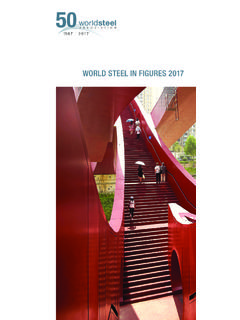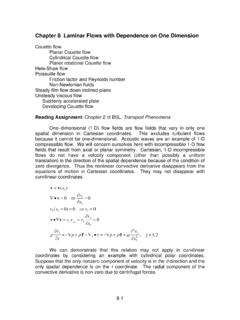Transcription of STEEL IN THE CIRCULAR ECONOMY A life cycle perspective
1 STEEL IN THE CIRCULAR ECONOMY . A life cycle perspective CONTENTS. Foreword 3. The CIRCULAR ECONOMY 4. Life cycle thinking 6. The life cycle assessment (LCA) approach 8. worldsteel's LCA methodology and life cycle inventory (LCI) database 10. Sustainability and life cycle assessment 12. LCA in the STEEL industry 14. LCA by life cycle phase 15. Raw materials and STEEL production 15. Markets for by-products 16. Manufacturing and use 16. Reuse and remanufacturing 18. Recycling 19. LCA initiatives 20. Regional and global initiatives 21. Market sector initiatives 22.
2 Construction 22. Automotive 24. Packaging 25. End notes 28. Glossary 29. Cover image: STEEL staircase, office building, Prague, Czech Republic Design: FOREWORD. We live in a rapidly changing world with finite resources. Too many legislative bodies around the world At the same time, improvements in standards of living still enact regulations which only affect the use and eradication of poverty, combined with global phase of a product's life, for example water and population growth, exert pressure on our ecosystems. energy consumption for washing machines, energy consumption for a fridge or CO2 emissions whilst As STEEL is everywhere in our lives and is at the heart driving a vehicle.
3 This focus on the use phase can of our sustainable future, our industry is an integral part lead to more expensive alternative lower density of the global CIRCULAR ECONOMY . The CIRCULAR ECONOMY materials being employed but which typically have a promotes zero waste, reduces the amount of materials higher environmental burden when the whole life cycle used, and encourages the reuse and recycling of is considered. materials, all fundamental advantages of using STEEL . This offers a markedly different approach and outcome This use phase limitation cannot continue.
4 Life cycle to the take, make, consume and dispose economic thinking must become a key requirement for all model the world has been used to. manufacturing decisions. This publication focuses on the importance of a life cycle approach in delivering true sustainability. It highlights for legislators and industry decision makers the importance of analysing the entire life cycle of a product before making legislative or manufacturing material decisions. Dr Edwin Basson Director General World STEEL Association We would like to dedicate this publication to the memory of Jean-S bastien Thomas (ArcelorMittal).
5 Who very sadly died recently. Jean-S bastien was Chairman of the worldsteel LCA Expert Group for the last three years and was a committed and enthusiastic driving force behind our life cycle activities. Much of his passion and knowledge is incorporated in this publication. For more information about the technical terms used in this brochure, please see the Glossary, page 29. Linear business model LINEAR BUSINESS MODEL. DESIGN RAW MATERIALS PRODUCTION MANUFACTURING USE DISPOSAL. STEEL in the CIRCULAR ECONOMY THE CIRCULAR ECONOMY . The STEEL industry is an integral part of the CIRCULAR ECONOMY model.
6 The CIRCULAR ECONOMY promotes zero waste, reuse of materials and recycling. It offers a markedly different approach and outcome to the take, make, consume and dispose'. economic model currently in use.. Dr Edwin Basson, Director General worldsteel The CIRCULAR ECONOMY is a move from linear business REUSE: Because of its durability, STEEL can be models, in which products are manufactured from reused or repurposed in many ways, with or without raw materials and then discarded at the end of remanufacturing. This already occurs with automotive their useful lives, to CIRCULAR business models where components, buildings, train rails and many other intelligent design leads to products or their parts being applications.
7 Reuse of STEEL is not limited to its original repaired, reused, returned and A CIRCULAR application; repurposing dates back to ancient ECONOMY aims to rebuild capital, whether it is financial, times (turning swords into ploughshares). Reuse manufacturing, human, social or natural. This approach occurs in sectors where it is technically possible enhances the flow of goods and without reducing safety, mechanical properties and/. or warranties. Rates of reuse will increase as eco- The concept of the CIRCULAR ECONOMY drives optimal design, design for reuse and recycling, and resource resource efficiency.
8 It makes sure that resources efficiency become more commonplace. are efficiently allocated to products and services in such a way as to maximise the economic well- REMANUFACTURE: Many STEEL products, such being of everyone. In addition, products need to be as automotive engines and wind turbines, can be designed to be durable, easy to repair and, ultimately, remanufactured for reuse to take advantage of the to be recycled. The cost of reusing, repairing or durability of STEEL components. Remanufacturing remanufacturing products has to be competitive to restores durable used products to like-new encourage these practices.
9 Simply replacing a product It differs from repair, which is a process with a new one should no longer be the norm. limited to making the product operational, as opposed to thorough disassembly and restoration A CIRCULAR ECONOMY ensures that value is maintained with the possible inclusion of new within a product when it reaches the end of its useful life while at the same time reducing or eliminating R. ECYCLE: Recycling has been carried out in the waste. This idea is fundamental to the triple-bottom-line STEEL industry since STEEL was first made.
10 STEEL is concept of sustainability, which focuses on the interplay 100% recyclable and can be recycled over and between environmental, social and economic factors. over again to create new STEEL products in a closed Without a life cycle approach, it is impossible to material loop. Recycled STEEL maintains the inherent have a genuine CIRCULAR ECONOMY . properties of the original STEEL . The magnetic property of STEEL ensures easy and affordable recovery for In a well-structured CIRCULAR ECONOMY , the STEEL recycling from almost any waste stream while the industry has significant competitive advantages high value of STEEL scrap guarantees the economic over competing materials.











